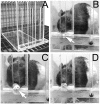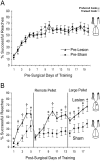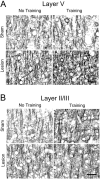Unilateral sensorimotor cortex lesions in adult rats facilitate motor skill learning with the "unaffected" forelimb and training-induced dendritic structural plasticity in the motor cortex
- PMID: 12351733
- PMCID: PMC6757779
- DOI: 10.1523/JNEUROSCI.22-19-08597.2002
Unilateral sensorimotor cortex lesions in adult rats facilitate motor skill learning with the "unaffected" forelimb and training-induced dendritic structural plasticity in the motor cortex
Abstract
In humans and other animals, sufficient unilateral damage to the sensorimotor cortex can cause impairments in the opposite forelimb and the development of a hyper-reliance on the nonimpaired limb. This hyper-reliance is adaptive to the extent that it contributes to functional compensation for lesion-induced impairments. We have found that unilateral lesions of the forelimb region of the sensorimotor cortex (FLsmc) in rats, or callosal transections, cause neurons of the opposite motor cortex to become exceptionally responsive to changes in forelimb behavior. This enhanced responsiveness might facilitate learning of compensatory strategies with the nonimpaired forelimb after unilateral FLsmc lesions. The possibility that these lesions facilitate learning with the nonimpaired forelimb was addressed in this study. Rats were required to learn a skilled forelimb reaching task after either unilateral FLsmc lesions or sham operations. The trained limb in animals with lesions was the nonimpaired limb. Compared with shams, rats with unilateral lesions had a greater rate of acquisition and asymptotic performance level on the task, which was especially evident on more difficult trials. Quantitative measures of microtubule associated protein-2 (MAP2) immunostained dendrites indicated an enhancement of training-induced dendritic cytoskeletal changes in the motor cortex opposite lesions. Thus, unilateral FLsmc lesions facilitate learning of at least some types of motor skills using the nonimpaired forelimb as well as some of the neuronal changes associated with this learning. This facilitation could be a substrate underlying behavioral compensation for unilateral FLsmc damage and may contribute to the phenomenon of learned nonuse of the impaired limb.
Figures








References
-
- Adams FS, Schwarting RK, Huston JP. Behavioral and neurochemical asymmetries following unilateral trephination of the rat skull: is this control operation always appropriate? Physiol Behav. 1994;55:947–952. - PubMed
-
- Adkins DL, Bury SD, Jones TA. Callosal denervation and forelimb behavioral change result in laminar dependent dendritic and spine alterations in the motor cortex of adult rats. Neurobiol Learn Mem. 2002;78:35–52. - PubMed
-
- Audesirk G, Cabell L, Kern M. Modulation of neurite branching by protein phosphorylation in cultured rat hippocampal neurons. Dev Brain Res. 1997;102:247–260. - PubMed
-
- Baddeley AJ, Gundersen HJG, Cruz-Orvie LM. Estimation of surface area from vertical sections. J Neurosci Methods. 1986;48:141–148. - PubMed
Publication types
MeSH terms
Substances
Grants and funding
LinkOut - more resources
Full Text Sources
